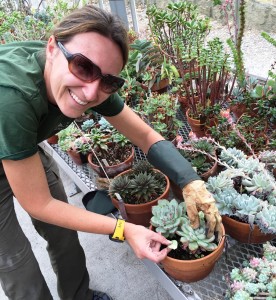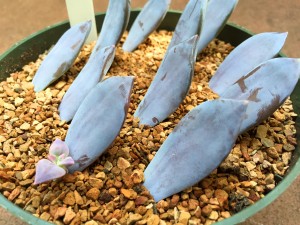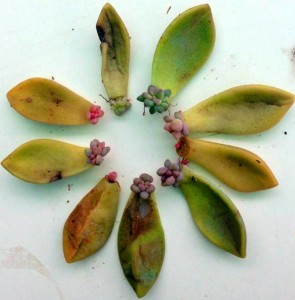Leaf Propagation: A Succulent Shared
Posted in Horticulture on October 20 2014, by Christian Primeau
Christian Primeau is the NYBG‘s Manager of the Enid A. Haupt Conservatory.

Who doesn’t love a sharer? Not an over-sharer, like Harold in Accounting, whose detailed inquest into his latest digestive afflictions has positively ruined my lunch hour three days running (I’m a horticulturist, not a doctor, Harold…we’ve been over this). No, I’m referring to the sweet woman who makes popcorn and secretly gifts you a handful, or the savior who brings coffee for everyone on Monday morning. And while you won’t even get within visual range of any popcorn or coffee in my possession, I am a prolific sharer of plants, so I do have a few friends left about the office.
Propagating plants can be as painless and satisfying as popping corn, pressing “brew” on the coffee machine, or simply eating lunch outside under a shady tree to avoid Harold. This is especially true of rosette succulents like Echeveria. Often referred to as Mexican Hens and Chicks, these Central and South American species adore sun, tolerate neglect, and exhibit a vast array of captivating leaf forms as well as flower and foliage colors. Truth be told, it’s a painfully easy group of plants to become enamored with and collect. The good news is that propagating and sharing your echeverias is a great way to make someone’s day and assuage the guilt of having spent far too much money on internet plant auctions. Be sure to remind your very patient and understanding spouse that smiles are priceless. PRICELESS.

Luckily, one Echeveria can yield a bounty of babies (and therefore smiles!) A word of warning, however: the first act involves courage as it entails “decimating” your lovely plant by gently detaching each mature leaf from the stem. Fear not—every thick, succulent leaf is a self-contained “power pack” with the ability to continue photosynthesizing and enough stored moisture to put that energy to immediate use growing new roots and leaves.
The second step is no more challenging. Simply lay each leaf directly on the surface of a moistened, well-drained cactus/succulent soil mix, or bury the detached end of each leaf in the medium at a 45-degree angle, tamping lightly around the base to secure it firmly in position. Place your leaf cuttings in bright, indirect light in a warm, well ventilated area.

For the next four to five weeks you’ll play the waiting game. If you keep the mix ever so slightly moist during that time, you will experience what I find to be one of the most rewarding aspects of horticulture. From the base of each leaf will emerge delicate young roots followed by one or more miniature new rosettes. These rosettes will grow and strengthen, absorbing moisture and nutrients in the soil as well as the still-attached “mother leaf.”
When the original leaf begins to yellow and shrivel, you can carefully transplant each new rosette into its own little pot. You are now poised to shower your friends and coworkers with leafy love. Yes…even Harold.
I encourage you to experiment with this simple propagation technique. Remember, it works just as well on Graptopetalum, Sedum, Kalanchoe, and many other succulent plant species. Have fun! Share! Go forth and multiply your plants!


I was reporring my escheveria today and have some spare leaves. I was about to throw it away, but you made me change my mind. I will plant them :)
Thanks for sharing!